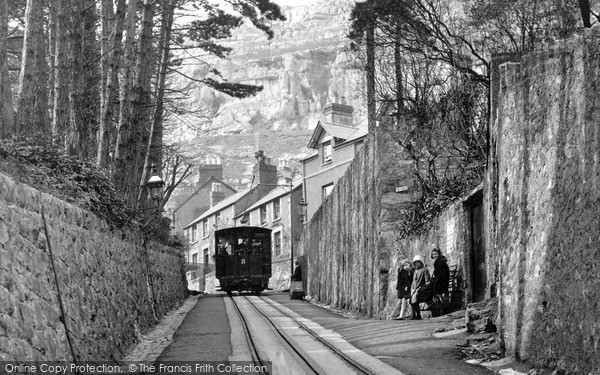''tram Crash On Tabor Hill''
A Memory of Llandudno.
On Tuesday, August 23rd 1932 there occurred at almost exactly the same spot from which this photo was taken, the most serious runaway and crash that ever ocurred on the line.
Car no. 4 broke away from the haulage cable at the spot that the tram is shown above. Rapidly gathering speed and toppling onto the wall to the left of the image, it uprooted a tramway standard (pole) flinging it up the lane by where the children are standing. The roof of the wildly canted tram crashed along the wall, this dislodged coping stones from the wall which fell into the tram causing passenger injuries. The driver, Edward Harris was thrown sideways from the front platform, into the wall and was sadly crushed to death. Apparently riding with the driver on the front platform, was a twelve year old girl named Margaret Worthington. She was badly injured and died at the local hospital within hours of the incident. Other passengers sitting near to the glazed bulkheads were thrown into the windows suffering severe cuts. Almost all of the others suffered severe shock and whiplash injuries. The conductor was Jim Coleburn who had jumped from the rear platform without injury.
The driver had courageously scooped up the child and was thrown from the tram with her in his arms. Sadly they were thrown between the wall and the tramcar....
Normally, such an act of bravery would earn substantial recognition but - passengers were not supposed to be carried on the platforms while the tram was in motion.
There were only three small motor ambulances available in the town that afternoon and they were soon overloaded. Some casualties were taken to the hospital by taxis impressed by a local Police sergeant. After treatment 20 passengers were released but 15 were either kept in hospital or had to receive ongoing attention.
Of the passengers, the most notable was the Bishop of Killaloe. Rabbi Harris Levin of Cheetham, Manchester was also on board, accompanied by his wife Sarah, who fared rather badly. This gentleman subsequently sued the Great Orme Tramway for the [then] enormous sum of £4000 for shock and injuries - a subsequent settlement was agreed at a more modest £1000 however. But there were also other claims of over £10,000 by other unfortunate travellers. The tramway company whilst viable was hardly awash with funds and these claims compelled the winding up of the company. Subsequently it passed into the hands of The Great Orme Railway Co. - but that's another story..
But what caused this catastrophe ?
All of the trams are connected to the haulage cables by means of a metal drawbar. This is in permanent grip with the haulage cable and is secured to the upper bogie between the wheels. It 'sticks down' through the slotted channels between the rails.
New drawbars had been manufactured by a Manchester company and one had recently been fitted to car 4. The 'Vibrac' steel had an internal directional tension in only one direction, wheras the tram drawbars required an internal tension in two directions, ie from top to bottom AND SIDE TO SIDE. Without 'sideways strength' the product was flawed and unfit for purpose. The tramway had ordered components without properly specifying the required qualities of the materials that the drawbars were to be made of! Disaster was inevitable...
Moreover, within a very short time of the tramway opening, it emerged that an emergency slot brake which had been initially fitted was removed from both lower section cars. So for almost thirty years the trams had gone up and down hill with only their wheel and slipper brakes operational! These facts became evident during the enquiry and subsequent report of February 1933.
On a more confident note, the trams were subsequently fitted with new highly efficient wheel, slipper and emergency brakes which remain in use today.
Just uphill of the children shown is a stone drinking fountain which is let into the wall. Sometimes called Idwal's Folly, it was fixed into the wall to provide refreshment [at one old penny for a cupful of sparkling cool water] for people walking up the hill. The crystal clear spring had appeared overnight and the nearest property owner, Idwal, cashed in ... A few months later the spring mysteriously dried up [shortly after another local house owner discovered a badly leaking water tap in the cellar of his home!!], leaving Idwal with a useless memorial to his folly and greed.
Add your comment
You must be signed-in to your Frith account to post a comment.
Add to Album
You must be signed in to save to an album
Sign inSparked a Memory for you?
If this has sparked a memory, why not share it here?


Comments & Feedback